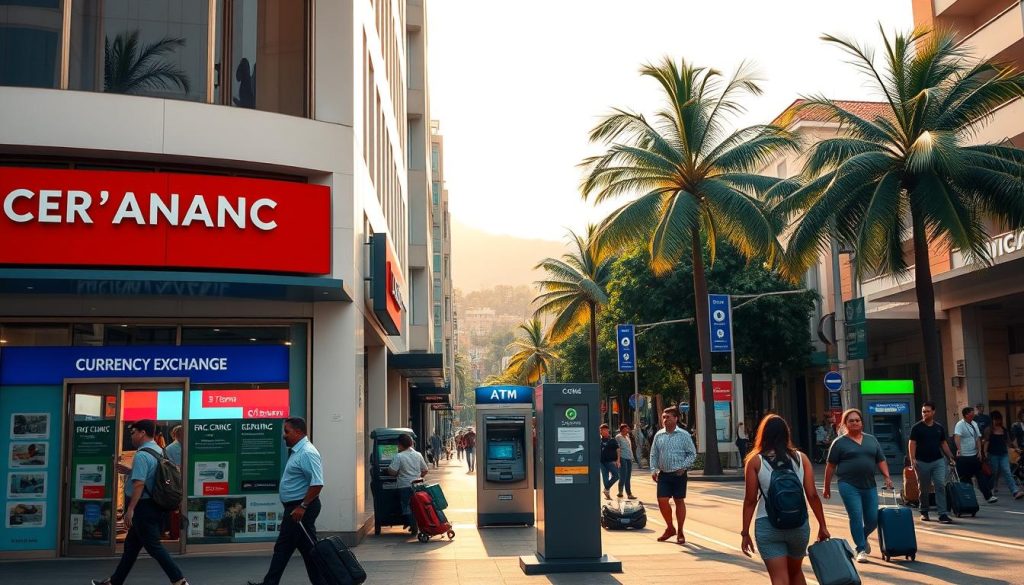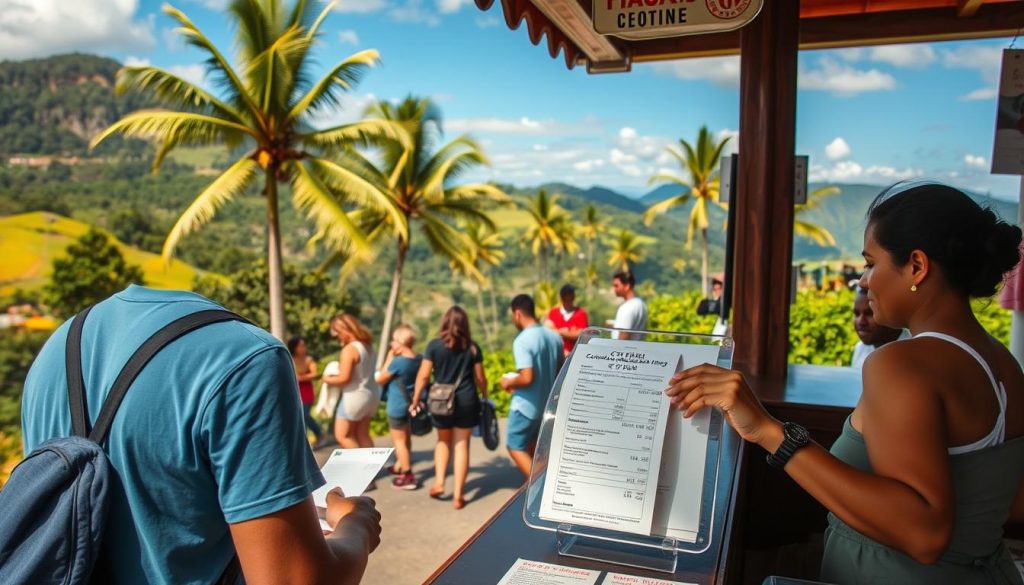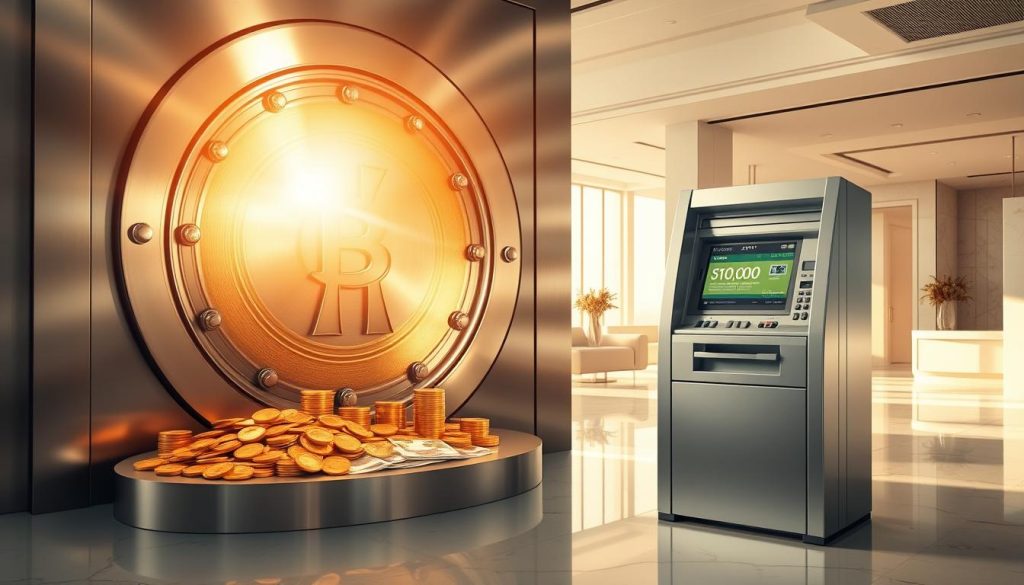✓ Tours & Activities ✓ Tours & Activities
Did you know that Costa Rica’s official currency, the Colón, has been in use since 1896? This small but vibrant country offers a unique blend of history and modern convenience when it comes to handling money. Whether you’re planning a short visit or an extended stay, understanding the local currency and payment methods can make your trip smoother and more enjoyable.
This guide is designed to help you navigate everything from exchanging USD to using ATMs and avoiding unnecessary fees. You’ll also learn about tipping customs, where to get the best exchange rates, and how to manage your money like a pro. With practical tips and reliable information, you’ll be well-prepared to make the most of your adventure in this beautiful destination.
Understanding the History and Evolution of Costa Rican Currency
The story of Costa Rican currency is a fascinating journey through time. From colonial coins to modern bills, the costa rican monetary system reflects the country’s rich history and cultural identity. Let’s explore how it evolved into what you use today.
From Spanish Pesos to the Modern Colón
During the colonial era, Spanish pesos were the primary currency costa rica used. These coins, minted in Spain, were later produced locally, marking the first step toward independence. The “Escudo” and “Real” were also widely used for daily transactions, laying the foundation for a unique monetary system.
After gaining independence in 1821, Costa Rica began adopting national symbols on its coin designs. Coffee, tobacco, the national flag, and the shield became prominent features, reflecting the country’s pride and heritage. This shift was a significant milestone in the evolution of its costa rica currency.
Key Milestones in Currency Development
In 1896, the modern colón was introduced, named after Christopher Columbus. This marked a new era for the costa rican economy. Over time, the currency underwent several updates, including the 1993 redesign, which introduced modern metal compositions and enhanced security features.
Today, the colón remains a symbol of national identity. Its evolution from colonial coins to modern bills showcases Costa Rica’s resilience and adaptability. Understanding this history adds depth to your experience when handling currency costa rica during your travels.
Navigating Currency Exchange and ATM Access in Costa Rica
Handling money while traveling can be tricky, but with the right tips, you can save time and avoid unnecessary fees. Whether you’re exchanging cash or withdrawing from an ATM, knowing the best practices will make your trip smoother.

Finding Reliable Banks and Exchange Bureaus
When exchanging currency, it’s important to choose trusted locations. Major banks like Banco Nacional and Scotiabank offer reliable services and competitive rates. Many of these institutions accept major currencies like US dollars, British pounds, and euros.
Exchange bureaus are also widely available, especially in tourist areas. However, be cautious of high fees or unfavorable rates at some locations. Always compare options before making a transaction.
Tips for Using ATMs Safely
ATMs, or cajeros automáticos, are convenient for withdrawing local currency. They are widely available and often operate 24/7. To avoid extra charges, check with your home bank about international fees before your trip.
For safety, use ATMs in well-lit, populated areas and avoid carrying large amounts of cash. Withdrawing larger sums at once can help minimize transaction fees. Remember, many ATMs allow you to choose between colones and US dollars.
“Planning ahead and staying informed can save you both time and money during your travels.”
By following these tips, you’ll be well-prepared to handle your finances efficiently and securely.
Managing USD and Colones for Everyday Transactions
Navigating currency options in a foreign country can be tricky, but understanding when to use US dollars or local colones can save you time and money. Knowing the right balance between the two will make your transactions smoother and more efficient.
Where and When to Use US Dollars
US dollars are widely accepted in many places, especially in upscale hotels, restaurants, and tourist areas. However, it’s essential to carry smaller bills like fives, tens, and twenties. Larger bills, such as fifties or hundreds, may be harder to use or result in unfavorable exchange rates.
For larger purchases or services, paying in dollars can be convenient. But for smaller transactions, like buying snacks or using public transport, local colones are the better choice. Always check if the exchange rate offered is fair to avoid unnecessary losses.
The Importance of Carrying Colones
While dollars are accepted in many places, colones are essential for everyday expenses. Local markets, small shops, and public buses often only accept cash in colones. Carrying a mix of both currencies ensures you’re prepared for any situation.
Colones come in denominations ranging from 1,000 to 50,000 bills and coins from 5 to 500. Managing smaller bills and coins is helpful for tipping, small purchases, and avoiding the hassle of getting change.
“Carrying both currencies gives you flexibility and ensures you’re never caught off guard during your travels.”
Balancing Cash and Digital Payments
While cash is king for small transactions, digital payments like credit cards are widely accepted in larger establishments. Visa is the most commonly accepted card, while American Express is less so. Always check for additional fees when using cards abroad.
To avoid conversion losses, choose the right payment method based on the transaction size. For larger purchases, cards are convenient, but for smaller ones, cash in colones is ideal. This balance ensures you’re both flexible and cost-effective.
Breakdown of Travel Costs Across Different Budgets
Planning your trip expenses wisely can make your journey more enjoyable and stress-free. Whether you’re a budget traveler or seeking luxury, understanding daily costs helps you plan better. Below, we break down expenses for different budgets, including lodging, dining, and transportation.

Budget Traveler Essentials
For budget-conscious travelers, daily expenses can range from 28,000 to 34,000 CRC. Affordable lodging options like hostels or budget hotels cost around 9,000 to 13,000 CRC per night. Meals at local sodas (small eateries) are economical, with a typical dish costing 3,500 to 5,000 CRC.
Public transportation is a great way to save money. Local buses cost as little as 500 CRC per ride. Activities like visiting national parks have entry fees of 10 to 15 USD, making them accessible for budget travelers.
Midrange and High-End Options
Midrange travelers can expect daily costs of 62,000 to 72,000 CRC. Accommodation in comfortable hotels ranges from 30,000 to 35,000 CRC per night. Dining at midrange restaurants costs 15,000 to 20,000 CRC per meal, offering a mix of local and international cuisine.
For luxury travelers, daily expenses can go up to 119,000 to 135,000 CRC. High-end hotels and eco-lodges start at 55,000 CRC per night. Fine dining experiences range from 26,000 to 33,000 CRC per meal, offering gourmet options.
“Knowing your budget and planning ahead ensures a stress-free and enjoyable trip.”
| Category | Budget | Midrange | Luxury |
|---|---|---|---|
| Accommodation | 9,000-13,000 CRC | 30,000-35,000 CRC | 55,000-65,000 CRC |
| Food | 8,000-10,000 CRC | 15,000-20,000 CRC | 26,000-33,000 CRC |
| Transportation | 5,000 CRC | 9,000 CRC | 16,000-20,000 CRC |
| Activities | 6,000 CRC | 8,000-13,000 CRC | 22,000-27,000 CRC |
Seasonal variations can affect costs. During the dry season (December to April), prices for hotels and tours may increase. Traveling during the rainy season can save you money, as fewer tourists mean lower rates.
By understanding typical fees and expenses, you can create a balanced itinerary that fits your budget. Whether you’re exploring on a shoestring or indulging in luxury, planning ahead ensures a memorable trip.
Expert Tips on Credit and Debit Card Usage
Using credit and debit cards wisely can make your trip smoother and more secure. While cash is essential for small purchases, cards offer convenience and added protection. Here’s how to make the most of your card transactions during your travels.
Advantages of Using Credit Cards
Credit cards are widely accepted in middle and upscale establishments, including hotels, restaurants, and shops. Visa is the most commonly accepted card, while American Express is less so. Using a credit card offers several benefits:
- Security: Credit cards provide fraud protection, making them safer for larger transactions.
- Convenience: They eliminate the need to carry large amounts of cash.
- Rewards: Many cards offer travel rewards, such as points or cashback on purchases.
Always notify your bank before traveling to avoid any issues with international transactions.
Challenges with Debit Cards
While debit cards are useful for withdrawing cash, they may not be as widely accepted for payments. Some ATMs may not accept international debit cards, and using them for purchases can pose security risks. Additionally, debit cards often come with higher fees for international transactions.
When to Use Cards vs. Cash
For optimal protection against fraud, use credit cards for larger purchases and online bookings. Cash is better for small transactions, such as tips, snacks, and local markets. Always check for dynamic currency conversion fees, as they can increase your costs.
“Using the right payment method at the right time ensures both convenience and security during your travels.”
Practical Tips for Card Usage
Here are some practical tips to avoid costly mistakes:
- Read transaction details carefully to avoid unnecessary fees.
- Choose to be charged in the local currency to avoid dynamic currency conversion fees.
- Carry a backup card in case of loss or theft.
By following these tips, you can manage your finances efficiently and enjoy a stress-free trip.
Understanding Transaction Fees, Taxes, and Tipping Etiquette
Understanding the financial nuances of your destination can save you from unexpected expenses. Taxes, fees, and tipping customs vary widely, and knowing how they work ensures a smoother experience. Let’s break down what you need to know to manage your money wisely.

How Taxes Are Applied on Purchases
In many places, a 13% value-added tax (VAT) is added to most purchases, including meals, souvenirs, and accommodations. This tax is typically included in the final price, so you won’t need to calculate it separately. However, it’s good to be aware of it when budgeting.
Hotels often add a 3% tourist surcharge on top of the VAT. This means your total tax on accommodations can reach 16%. Always check your bill to understand these charges. For larger transactions, such as tours or services, taxes are usually listed separately.
Gratuity Practices in Restaurants and Services
Tipping is customary in many establishments. In restaurants, a 10% service charge is often added to your bill. This is considered a standard tip for waitstaff. If you receive exceptional service, you can leave an additional amount in local currency.
For other services, such as bellhops or drivers, tipping is appreciated but not mandatory. A small amount, like 500 to 1,000 colones, is usually sufficient. Always carry smaller bills for these transactions.
“Being aware of local customs and fees ensures you’re prepared for any financial situation during your travels.”
Here’s a quick guide to tipping etiquette:
- Restaurants: 10% service charge included; additional tips optional.
- Hotels: 3% surcharge; tips for staff like bellhops or housekeeping are appreciated.
- Drivers and Guides: 5 to 10 USD per day, depending on the service.
When using debit or credit cards, be mindful of foreign transaction fees. These can add up, especially for smaller purchases. Always check with your bank before traveling to understand these costs.
By planning ahead and staying informed, you can avoid unnecessary expenses and enjoy a stress-free trip.
Costa Rica: Ultimate Travelers Guide to Currencies & Payments
Managing your finances efficiently while traveling can make your trip smoother and more enjoyable. Whether you’re exchanging cash or using ATMs, knowing the best practices ensures you stay prepared for any situation.
Securing the Best Exchange Rates
To get the most out of your money, compare multiple service providers. Banks often offer competitive exchange rates, while services like Western Union can be convenient for larger transactions. Avoid airport and hotel counters, as they typically charge higher fees.
Always check the current tipo de cambio (exchange rate) before making transactions. This helps you avoid unfavorable rates and hidden charges. Planning ahead is especially important when traveling to rural areas, where currency exchange options may be limited.
Exchanging Money Safely
When exchanging cash, stick to reputable locations like banks or authorized bureaus. Be cautious of high commission fees and always ask for a receipt. Carrying smaller bills in local currency is ideal for everyday expenses.
Using ATMs is another convenient option. Look for machines marked with “ATH” (a todas horas) for 24/7 access. Withdraw larger sums at once to minimize transaction fees, but avoid carrying excessive cash for safety reasons.
“Comparing rates and planning ahead ensures you get the best value for your money.”
Planning for Rural Areas
In remote regions, access to ATMs and exchange services may be limited. Carry enough local currency to cover your needs, and consider using digital payment methods where possible. Notify your bank of your travel plans to avoid issues with card transactions.
By following these tips, you can manage your finances effectively and enjoy a stress-free trip. Whether you’re exploring cities or rural areas, staying informed and prepared makes all the difference.
Ensuring Money Safety and Secure Transactions
Keeping your money safe while traveling is essential for a stress-free experience. Whether you’re withdrawing cash or making purchases, taking precautions can protect you from fraud and ensure smooth transactions. Here’s how to stay secure and avoid common pitfalls.

Protecting Yourself Against Fraud
Financial fraud can happen anywhere, but being vigilant reduces the risk. Always use ATMs in well-lit, populated areas, and shield your PIN when entering it. Avoid sharing card details over unsecured networks, especially in public places.
When exchanging currency, stick to reputable banks or authorized bureaus. These locations verify cash authenticity, ensuring you receive genuine bills. Be cautious of street vendors offering too-good-to-be-true rates, as they may hand out counterfeit money.
Verifying Currency Authenticity
Not all bills are accepted costa rica widely. For example, US dollars in pristine condition are more likely to be accepted than worn or torn ones. Familiarize yourself with local currency features, such as watermarks and security threads, to spot fakes.
When receiving change, double-check the bills and coins. Some establishments may try to pass off outdated or damaged rica currency. If something feels off, politely ask for a replacement.
“Taking a few extra moments to verify your money can save you from costly mistakes.”
Practical Tips for Secure Transactions
Here are some additional strategies to keep your money costa rica safe:
- Withdraw cash during daylight hours for added security.
- Carry only the amount you need for the day to minimize losses if theft occurs.
- Use credit cards for larger purchases, as they offer fraud protection.
By following these tips, you can enjoy your trip without worrying about financial mishaps. Staying informed and prepared ensures your accepted costa transactions are smooth and secure.
Insider Advice for Exchanging and Withdrawing Cash
Exchanging and withdrawing cash efficiently can make a big difference in your travel experience. Knowing where to go and how to manage your money can save you time and avoid unnecessary fees. Here’s how to optimize your transactions and keep your finances secure.
Optimizing Exchange Rates and Minimizing Fees
Finding the best exchange rates starts with choosing the right locations. Banks and authorized exchange bureaus in the city often offer better rates than those at the airport. While airport exchanges are convenient, they typically charge higher fees and provide less favorable rates.
For the best value, compare rates at multiple service like providers. Local banks in major cities usually offer competitive rates. Avoid exchanging money at hotels or unlicensed vendors, as they may charge hidden fees or offer outdated rates.
Using ATMs Effectively
ATMs are a convenient way to withdraw local currency. Look for machines in secure locations, such as shopping malls or banks. Withdrawing larger amounts at once can help minimize transaction fees, but avoid carrying excessive cash for safety reasons.
In rural areas, ATMs may be less accessible. Plan ahead and carry enough cash to cover your needs. Notify your bank of your travel plans to avoid issues with international transactions.
Security Tips for Exchanging Money
Always exchange money during daylight hours and in well-lit, populated areas. Stick to reputable locations like banks or authorized bureaus to ensure you receive genuine bills. Be cautious of street vendors offering too-good-to-be-true rates, as they may hand out counterfeit money.
When receiving change, double-check the bills and coins. Some establishments may try to pass off outdated or damaged currency. If something feels off, politely ask for a replacement.
“Planning ahead and staying informed ensures you get the best value for your money while staying secure.”
Comparison of Exchange Options
| Location | Pros | Cons |
|---|---|---|
| Banks | Competitive rates, secure | May involve paperwork |
| Airport Exchanges | Convenient | Higher fees, unfavorable rates |
| Authorized Bureaus | Reliable, good rates | May have limited hours |
| Hotels | Quick | Less favorable rates |
By following these tips, you can manage your cash transactions efficiently and enjoy a stress-free trip. Whether you’re in a bustling city or a remote area, staying prepared makes all the difference.
Conclusion
Exploring a new destination is exciting, but managing your money wisely ensures a stress-free adventure. This guide has covered everything from the history of the currency costa to practical tips for handling cash and cards. Whether you’re using US dollars or local colones, balancing both is key for smooth transactions.
Remember to use ATMs in secure locations and notify your bank before traveling. Credit cards offer convenience and security, especially for larger purchases. Always carry smaller bills for tips and local markets. Understanding taxes and tipping customs will also help you navigate daily expenses with ease.
By following these insider tips, you can focus on enjoying your trip without financial worries. With proper planning, managing your money is simple and straightforward. Apply these strategies to make the most of your experience as a tourist and ensure every transaction is secure and efficient.
The above is subject to change.
Check back often to TRAVEL.COM for the latest travel tips and deals.





